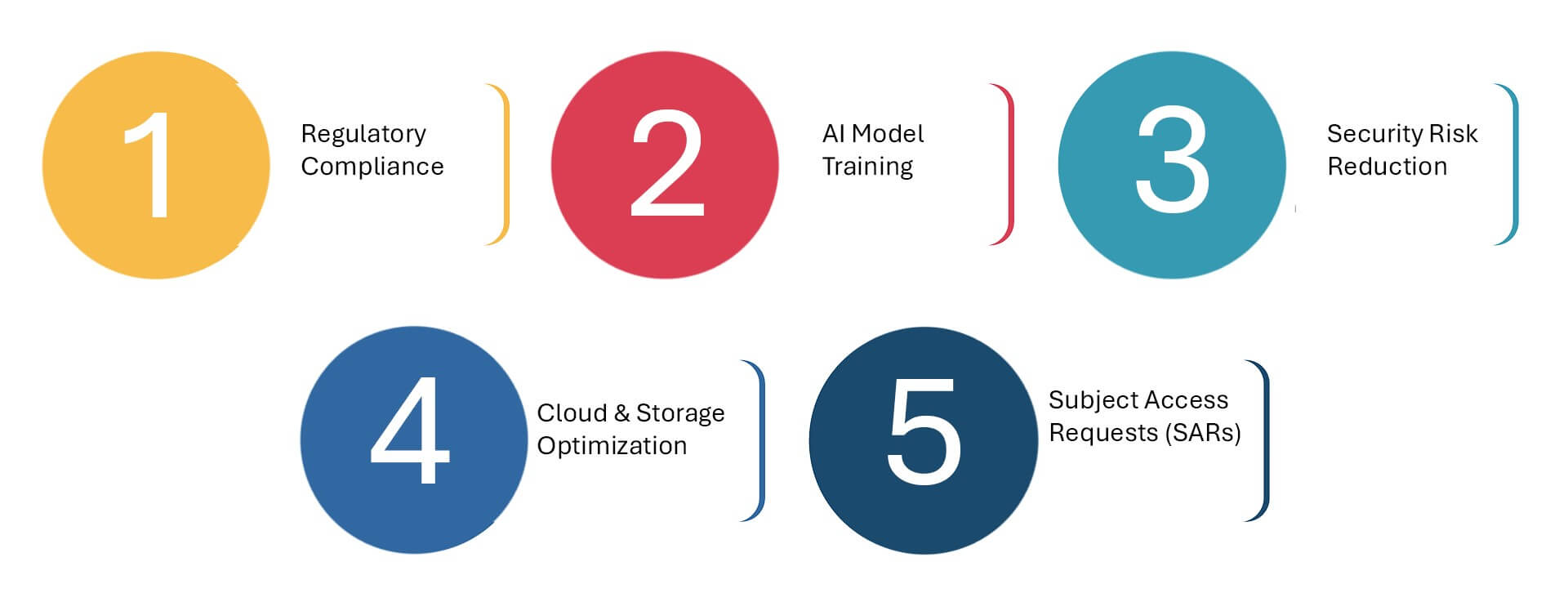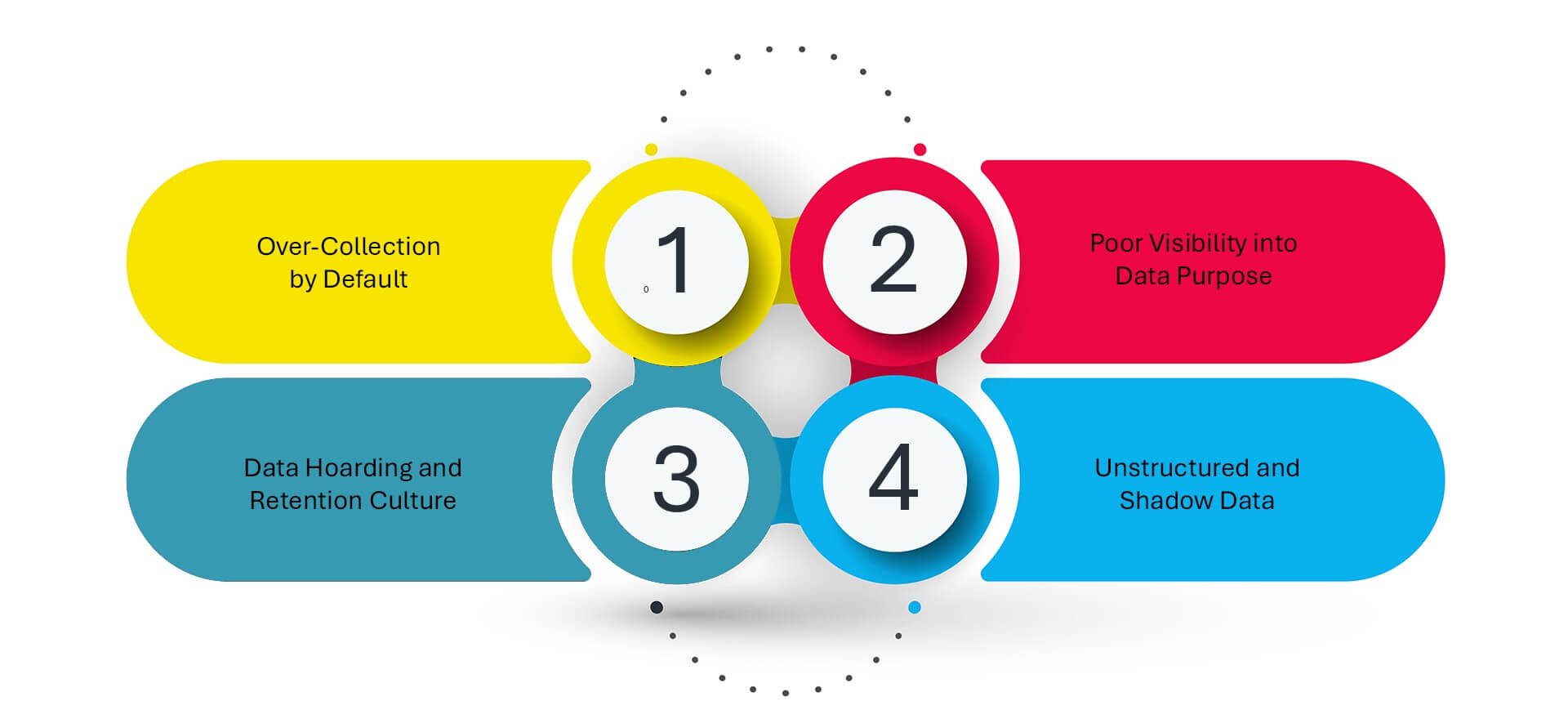What is Data Minimization?
Data Minimization is a strategic approach in data management and privacy that involves collecting, processing, and retaining only the minimum amount of personal data necessary to fulfill a specific purpose. The principle aims to reduce the risks associated with data breaches, unauthorized access, and non-compliance by limiting the volume of data collected and stored. By focusing on essential data, organizations enhance security, ensure regulatory compliance, and promote efficient data governance, while also respecting user privacy and reducing the potential impact of data misuse.
Put simply, if you don’t need the data, don’t collect it. And if you no longer need it, don’t keep it.
Why Data Minimization Matters
In today’s data-saturated enterprise environments, excess data isn’t just inefficient—it’s dangerous. Storing redundant, obsolete, or unnecessary data (ROT) creates avoidable risk, inflates infrastructure costs, and undermines trust. In fact, according to IBM, over 60% of sensitive data stored by enterprises is never used—yet remains vulnerable to breaches, legal exposure, and noncompliance.
Data minimization shifts the focus from “how much can we collect?” to “how little do we need?” This pivot is not only essential for regulatory compliance but also for building digital trust and improving system performance across the data lifecycle.
Core Principles of Data Minimization
- Purpose Limitation: Data should only be collected for a specific, lawful, and pre-defined use case.
- Necessity: Only data that is essential to fulfill the purpose should be captured and processed.
- Retention Limitation: Data must be deleted or anonymized once the purpose is fulfilled or retention deadlines expire.
- Proportionality: The data collected should be proportionate to the risks involved and the value it brings.
Key Use Cases of Data Minimization

- Regulatory Compliance: Reduces legal exposure by aligning with GDPR, DPDP, HIPAA, and other privacy frameworks that enforce purpose-bound data usage and timely deletion.
- AI Model Training: Improves ethical AI by avoiding overfitting or bias introduced by excessive or irrelevant data—particularly sensitive personal or demographic information.
- Security Risk Reduction: Minimizing data reduces the volume of sensitive material available to attackers, limiting blast radius during a breach, and strengthening overall security posture.
- Cloud & Storage Optimization: Helps lower operational costs and carbon footprint by eliminating data hoarding, streamlining cloud storage, and improving storage tiering strategies.
- Subject Access Requests (SARs): Simplifies and accelerates responses to SARs by ensuring only relevant and necessary data is retained and indexed for audit.
Challenges in Data Minimization – And What to Do About Them

Over-Collection by Default
Many systems are built to collect as much data as possible, regardless of whether it’s needed.
What to do: Redesign data intake forms, apps, and analytics pipelines with privacy-by-design principles. Conduct Data Protection Impact Assessments (DPIAs) to determine necessity upfront.
Poor Visibility into Data Purpose
Organizations often lack a clear mapping of what data supports which business process, making it difficult to define what’s truly necessary.
What to do: Build a purpose-driven data catalog with linked metadata, ownership, and retention requirements. Tag data based on purpose and sensitivity for automated enforcement.
Data Hoarding and Retention Culture
Fear of losing potential insights often leads to “keep everything” mentalities that undermine governance and increase liability.
What to do: Educate stakeholders on the risks of over-retention. Use dashboards to visualize ROT data, and enforce defensible deletion policies through automated lifecycle management.
Unstructured and Shadow Data
Unstructured files and collaboration platforms often contain duplicated, outdated, or hidden data that’s excluded from traditional governance.
What to do: Leverage AI-powered discovery tools to surface, classify, and triage shadow and unstructured data across cloud and edge environments. Apply smart archiving or redaction workflows.
Less Is More: Why Data Minimization Is the New Standard for Trustworthy AI and Privacy by Design
Data minimization has evolved from a compliance checkbox into a cornerstone of ethical, secure, and future-ready data strategies. As enterprises race to adopt AI and automate decision-making, the pressure is on to not just collect data—but to collect only the data that matters.
In AI pipelines, minimizing training data reduces the risk of embedding bias, simplifies model explainability, and ensures decisions can be traced back to data that is lawful, relevant, and necessary. It promotes ethical AI by design, where intelligence is derived responsibly, not opportunistically.
In privacy and cybersecurity architectures, data minimization aligns perfectly with Zero Trust principles—shrinking the attack surface by limiting what data is stored, who can access it, and for how long. It’s a built-in defense mechanism that reduces liability by design, not reaction.
But beyond security and AI performance, data minimization sends a powerful message: We respect your data. We only take what we need. And we don’t hold on to it longer than we should. That mindset doesn’t just satisfy regulators—it builds long-term digital trust.
Because in today’s economy, where data is both currency and vulnerability, the most forward-thinking organizations are proving their integrity not by what they collect, but by what they consciously choose not to.
Data minimization is the quiet powerhouse of modern data governance. It trims excess, sharpens compliance, strengthens security, and accelerates insight—all while upholding the principle that people’s data deserves respect, purpose, and protection.
In an age of AI acceleration and rising digital accountability, what you choose not to collect may say more about your organization than what you do.
Getting Started with Data Dynamics:
- Learn about Unstructured Data Management
- Schedule a demo with our team
- Read the latest blog: How Data Sovereignty Is Challenging Data Governance — And What the Future Demands






